Taxation Law Assignment: Mr. Phillips Land Sale and Taxation
VerifiedAdded on 2020/04/07
|10
|1777
|34
Homework Assignment
AI Summary
This assignment analyzes a taxation law case concerning Mr. Phillips and the sale of his land, exploring whether the transaction constitutes a mere realization or an isolated transaction subject to taxation under the ITAA 1936. It delves into the application of Taxation Ruling TR 92/3 and relevant case law, such as FC of T v The Myer Emporium Ltd (1987), to determine the tax implications. The assignment includes a capital gains tax (CGT) calculation under both old and new regimes, considering the sale price, purchase price, and associated costs. It also addresses the subdivision of land and its impact on CGT, referencing guidelines from the Australian Taxation Office and relevant sections of the ITAA 1997. The document concludes by determining whether the profits derived by Mr. Phillips would be assessed under Section 26 (a) and 25 (1) of the ITAA 1936, and includes a comprehensive reference list of relevant legal texts and rulings.
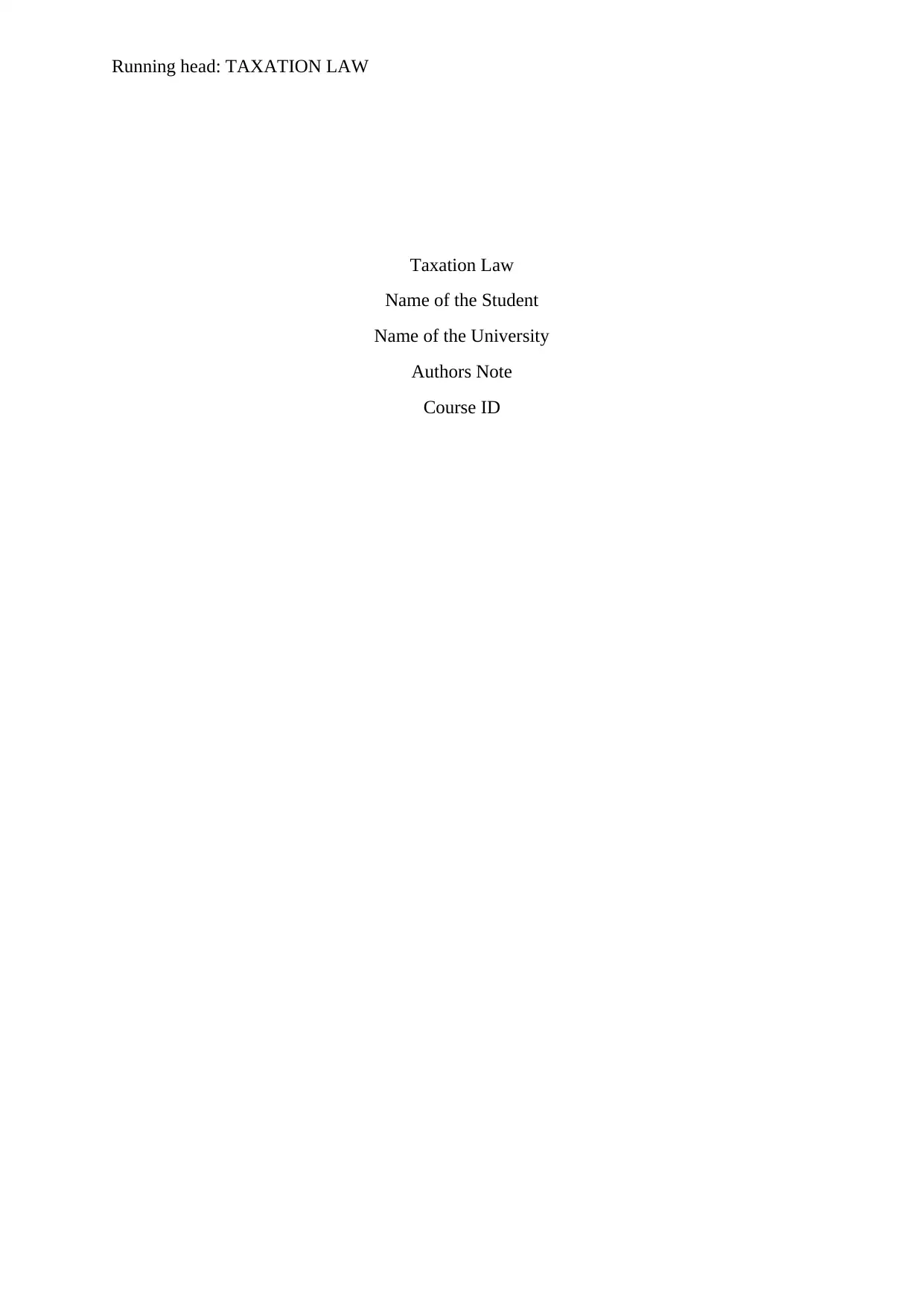
Running head: TAXATION LAW
Taxation Law
Name of the Student
Name of the University
Authors Note
Course ID
Taxation Law
Name of the Student
Name of the University
Authors Note
Course ID
Paraphrase This Document
Need a fresh take? Get an instant paraphrase of this document with our AI Paraphraser
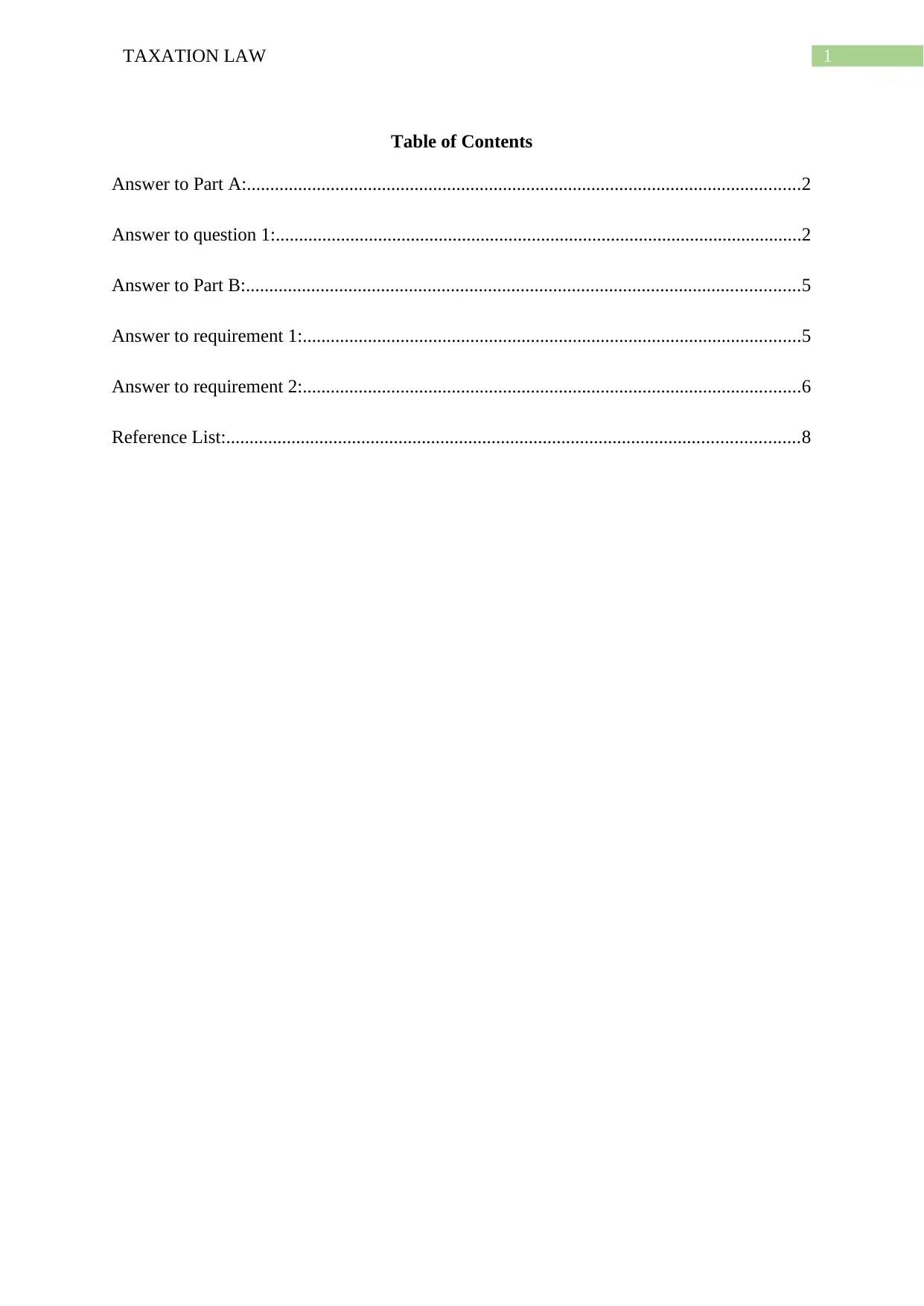
1TAXATION LAW
Table of Contents
Answer to Part A:.......................................................................................................................2
Answer to question 1:.................................................................................................................2
Answer to Part B:.......................................................................................................................5
Answer to requirement 1:...........................................................................................................5
Answer to requirement 2:...........................................................................................................6
Reference List:...........................................................................................................................8
Table of Contents
Answer to Part A:.......................................................................................................................2
Answer to question 1:.................................................................................................................2
Answer to Part B:.......................................................................................................................5
Answer to requirement 1:...........................................................................................................5
Answer to requirement 2:...........................................................................................................6
Reference List:...........................................................................................................................8
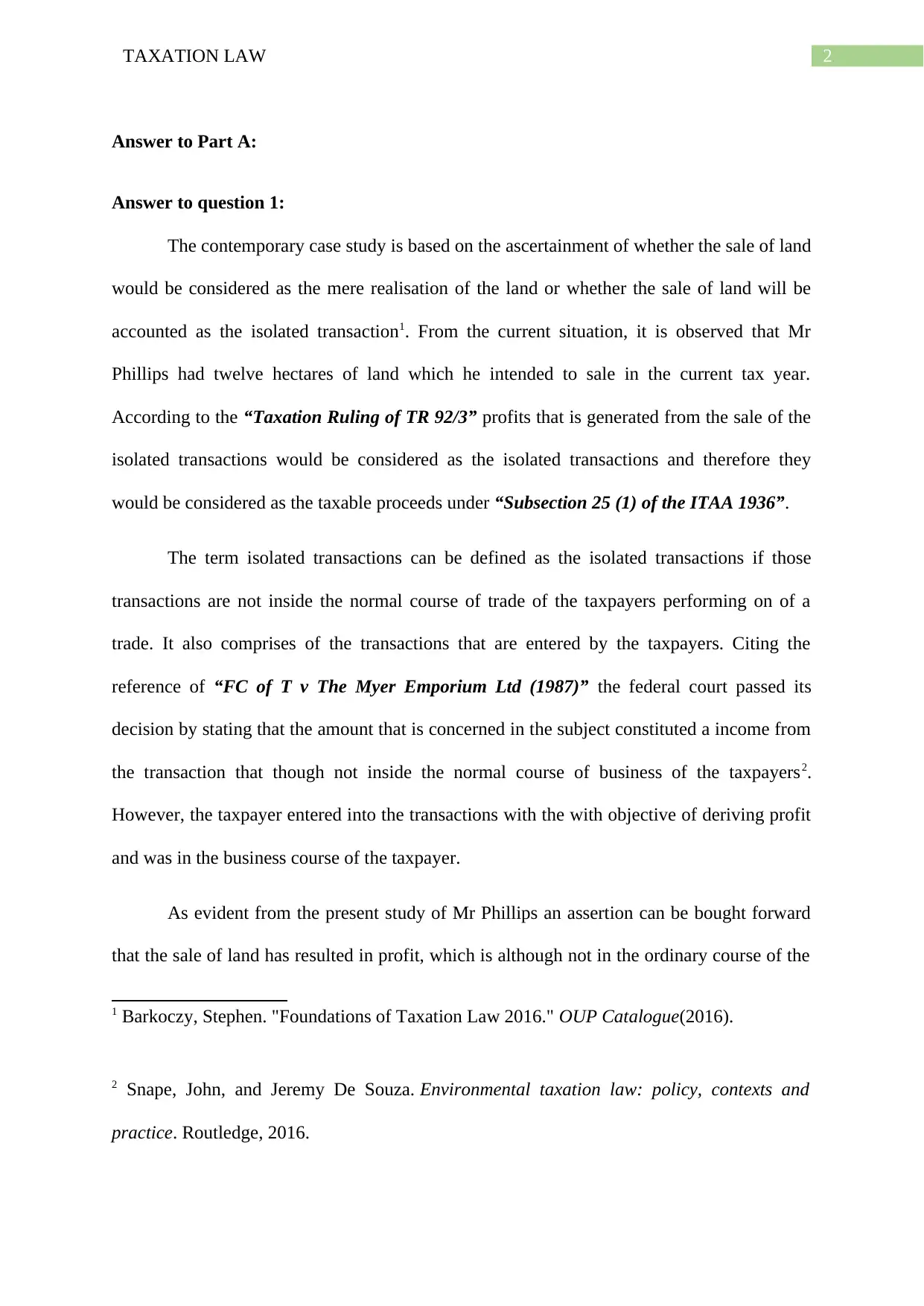
2TAXATION LAW
Answer to Part A:
Answer to question 1:
The contemporary case study is based on the ascertainment of whether the sale of land
would be considered as the mere realisation of the land or whether the sale of land will be
accounted as the isolated transaction1. From the current situation, it is observed that Mr
Phillips had twelve hectares of land which he intended to sale in the current tax year.
According to the “Taxation Ruling of TR 92/3” profits that is generated from the sale of the
isolated transactions would be considered as the isolated transactions and therefore they
would be considered as the taxable proceeds under “Subsection 25 (1) of the ITAA 1936”.
The term isolated transactions can be defined as the isolated transactions if those
transactions are not inside the normal course of trade of the taxpayers performing on of a
trade. It also comprises of the transactions that are entered by the taxpayers. Citing the
reference of “FC of T v The Myer Emporium Ltd (1987)” the federal court passed its
decision by stating that the amount that is concerned in the subject constituted a income from
the transaction that though not inside the normal course of business of the taxpayers2.
However, the taxpayer entered into the transactions with the with objective of deriving profit
and was in the business course of the taxpayer.
As evident from the present study of Mr Phillips an assertion can be bought forward
that the sale of land has resulted in profit, which is although not in the ordinary course of the
1 Barkoczy, Stephen. "Foundations of Taxation Law 2016." OUP Catalogue(2016).
2 Snape, John, and Jeremy De Souza. Environmental taxation law: policy, contexts and
practice. Routledge, 2016.
Answer to Part A:
Answer to question 1:
The contemporary case study is based on the ascertainment of whether the sale of land
would be considered as the mere realisation of the land or whether the sale of land will be
accounted as the isolated transaction1. From the current situation, it is observed that Mr
Phillips had twelve hectares of land which he intended to sale in the current tax year.
According to the “Taxation Ruling of TR 92/3” profits that is generated from the sale of the
isolated transactions would be considered as the isolated transactions and therefore they
would be considered as the taxable proceeds under “Subsection 25 (1) of the ITAA 1936”.
The term isolated transactions can be defined as the isolated transactions if those
transactions are not inside the normal course of trade of the taxpayers performing on of a
trade. It also comprises of the transactions that are entered by the taxpayers. Citing the
reference of “FC of T v The Myer Emporium Ltd (1987)” the federal court passed its
decision by stating that the amount that is concerned in the subject constituted a income from
the transaction that though not inside the normal course of business of the taxpayers2.
However, the taxpayer entered into the transactions with the with objective of deriving profit
and was in the business course of the taxpayer.
As evident from the present study of Mr Phillips an assertion can be bought forward
that the sale of land has resulted in profit, which is although not in the ordinary course of the
1 Barkoczy, Stephen. "Foundations of Taxation Law 2016." OUP Catalogue(2016).
2 Snape, John, and Jeremy De Souza. Environmental taxation law: policy, contexts and
practice. Routledge, 2016.
⊘ This is a preview!⊘
Do you want full access?
Subscribe today to unlock all pages.

Trusted by 1+ million students worldwide
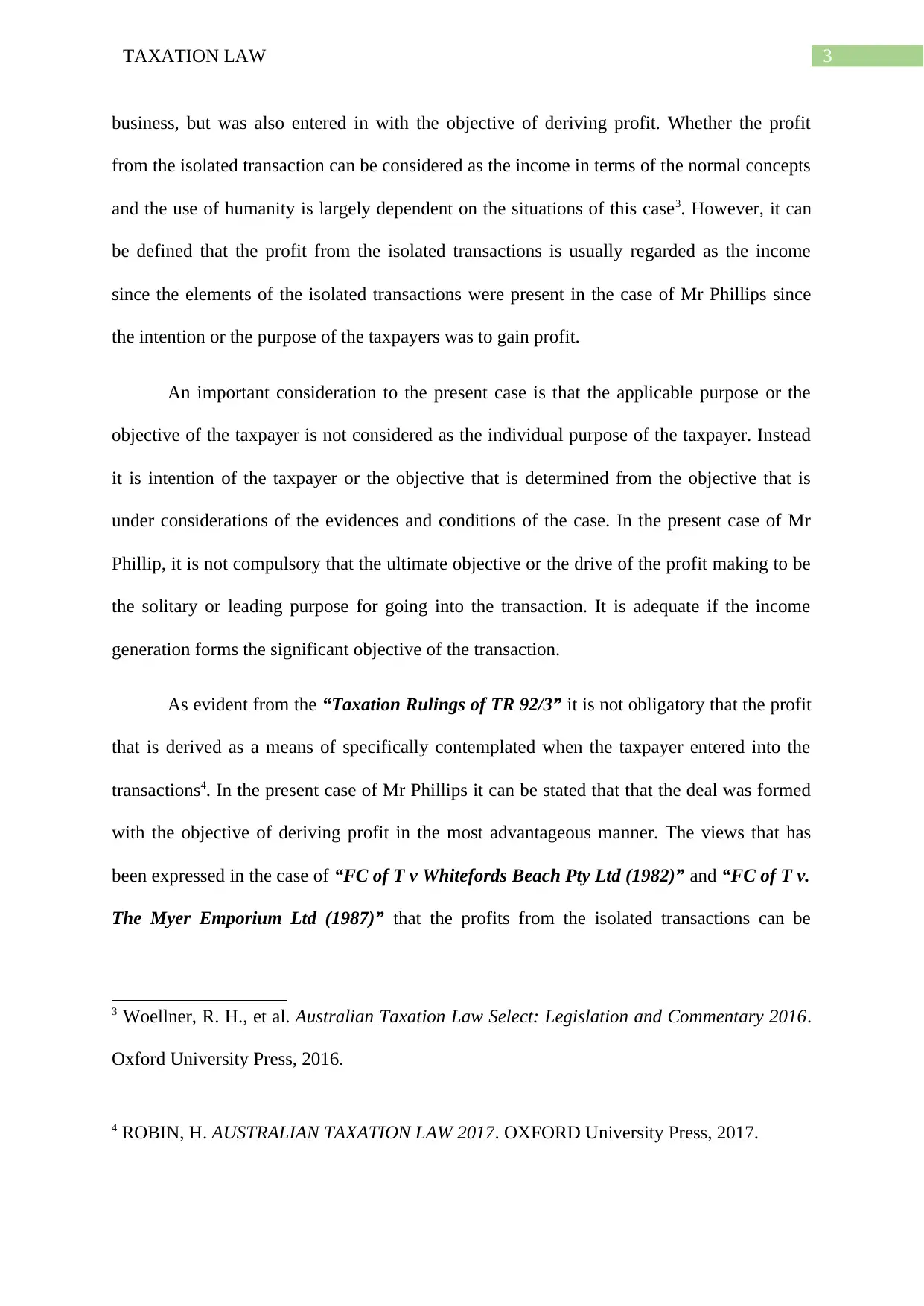
3TAXATION LAW
business, but was also entered in with the objective of deriving profit. Whether the profit
from the isolated transaction can be considered as the income in terms of the normal concepts
and the use of humanity is largely dependent on the situations of this case3. However, it can
be defined that the profit from the isolated transactions is usually regarded as the income
since the elements of the isolated transactions were present in the case of Mr Phillips since
the intention or the purpose of the taxpayers was to gain profit.
An important consideration to the present case is that the applicable purpose or the
objective of the taxpayer is not considered as the individual purpose of the taxpayer. Instead
it is intention of the taxpayer or the objective that is determined from the objective that is
under considerations of the evidences and conditions of the case. In the present case of Mr
Phillip, it is not compulsory that the ultimate objective or the drive of the profit making to be
the solitary or leading purpose for going into the transaction. It is adequate if the income
generation forms the significant objective of the transaction.
As evident from the “Taxation Rulings of TR 92/3” it is not obligatory that the profit
that is derived as a means of specifically contemplated when the taxpayer entered into the
transactions4. In the present case of Mr Phillips it can be stated that that the deal was formed
with the objective of deriving profit in the most advantageous manner. The views that has
been expressed in the case of “FC of T v Whitefords Beach Pty Ltd (1982)” and “FC of T v.
The Myer Emporium Ltd (1987)” that the profits from the isolated transactions can be
3 Woellner, R. H., et al. Australian Taxation Law Select: Legislation and Commentary 2016.
Oxford University Press, 2016.
4 ROBIN, H. AUSTRALIAN TAXATION LAW 2017. OXFORD University Press, 2017.
business, but was also entered in with the objective of deriving profit. Whether the profit
from the isolated transaction can be considered as the income in terms of the normal concepts
and the use of humanity is largely dependent on the situations of this case3. However, it can
be defined that the profit from the isolated transactions is usually regarded as the income
since the elements of the isolated transactions were present in the case of Mr Phillips since
the intention or the purpose of the taxpayers was to gain profit.
An important consideration to the present case is that the applicable purpose or the
objective of the taxpayer is not considered as the individual purpose of the taxpayer. Instead
it is intention of the taxpayer or the objective that is determined from the objective that is
under considerations of the evidences and conditions of the case. In the present case of Mr
Phillip, it is not compulsory that the ultimate objective or the drive of the profit making to be
the solitary or leading purpose for going into the transaction. It is adequate if the income
generation forms the significant objective of the transaction.
As evident from the “Taxation Rulings of TR 92/3” it is not obligatory that the profit
that is derived as a means of specifically contemplated when the taxpayer entered into the
transactions4. In the present case of Mr Phillips it can be stated that that the deal was formed
with the objective of deriving profit in the most advantageous manner. The views that has
been expressed in the case of “FC of T v Whitefords Beach Pty Ltd (1982)” and “FC of T v.
The Myer Emporium Ltd (1987)” that the profits from the isolated transactions can be
3 Woellner, R. H., et al. Australian Taxation Law Select: Legislation and Commentary 2016.
Oxford University Press, 2016.
4 ROBIN, H. AUSTRALIAN TAXATION LAW 2017. OXFORD University Press, 2017.
Paraphrase This Document
Need a fresh take? Get an instant paraphrase of this document with our AI Paraphraser
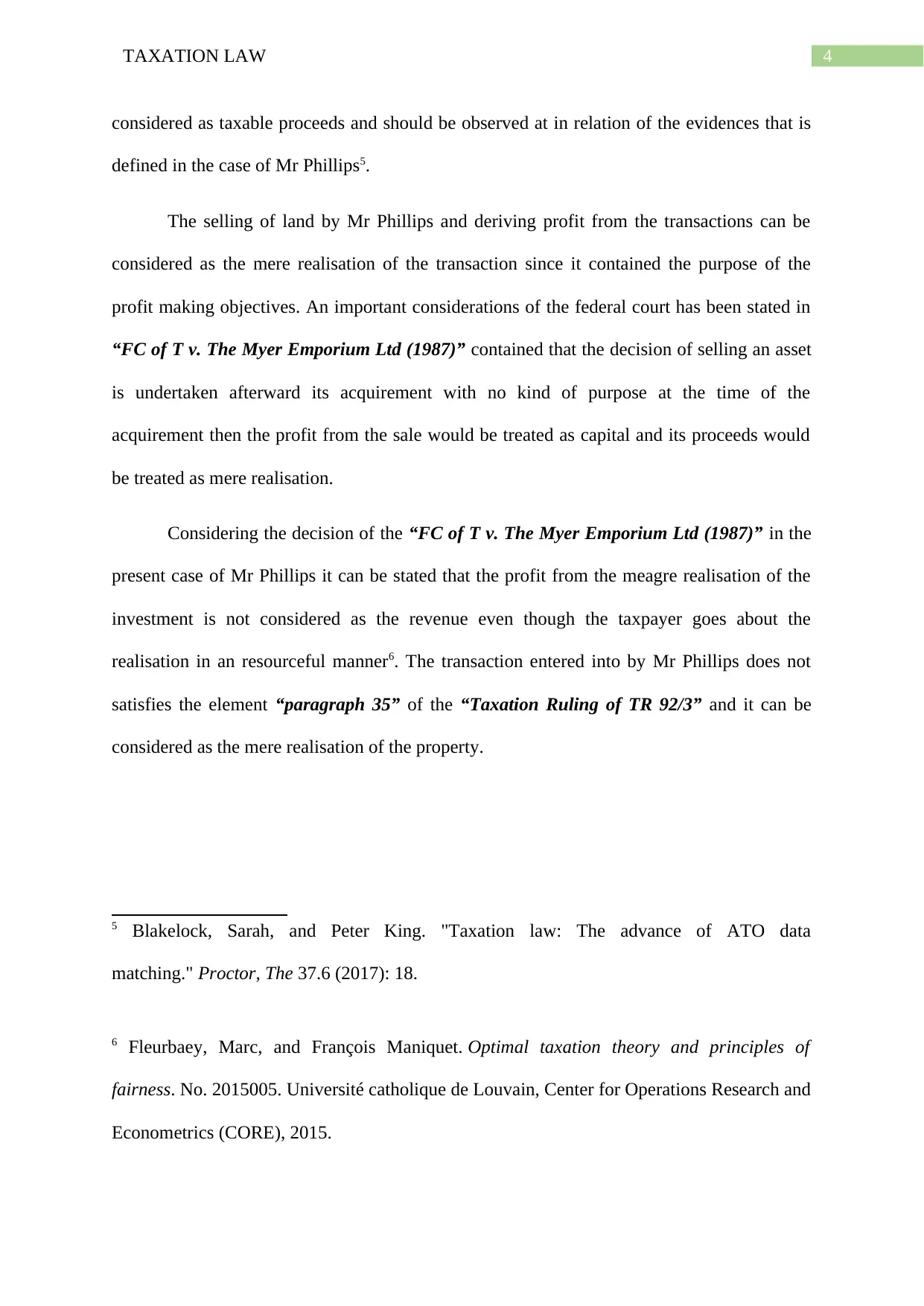
4TAXATION LAW
considered as taxable proceeds and should be observed at in relation of the evidences that is
defined in the case of Mr Phillips5.
The selling of land by Mr Phillips and deriving profit from the transactions can be
considered as the mere realisation of the transaction since it contained the purpose of the
profit making objectives. An important considerations of the federal court has been stated in
“FC of T v. The Myer Emporium Ltd (1987)” contained that the decision of selling an asset
is undertaken afterward its acquirement with no kind of purpose at the time of the
acquirement then the profit from the sale would be treated as capital and its proceeds would
be treated as mere realisation.
Considering the decision of the “FC of T v. The Myer Emporium Ltd (1987)” in the
present case of Mr Phillips it can be stated that the profit from the meagre realisation of the
investment is not considered as the revenue even though the taxpayer goes about the
realisation in an resourceful manner6. The transaction entered into by Mr Phillips does not
satisfies the element “paragraph 35” of the “Taxation Ruling of TR 92/3” and it can be
considered as the mere realisation of the property.
5 Blakelock, Sarah, and Peter King. "Taxation law: The advance of ATO data
matching." Proctor, The 37.6 (2017): 18.
6 Fleurbaey, Marc, and François Maniquet. Optimal taxation theory and principles of
fairness. No. 2015005. Université catholique de Louvain, Center for Operations Research and
Econometrics (CORE), 2015.
considered as taxable proceeds and should be observed at in relation of the evidences that is
defined in the case of Mr Phillips5.
The selling of land by Mr Phillips and deriving profit from the transactions can be
considered as the mere realisation of the transaction since it contained the purpose of the
profit making objectives. An important considerations of the federal court has been stated in
“FC of T v. The Myer Emporium Ltd (1987)” contained that the decision of selling an asset
is undertaken afterward its acquirement with no kind of purpose at the time of the
acquirement then the profit from the sale would be treated as capital and its proceeds would
be treated as mere realisation.
Considering the decision of the “FC of T v. The Myer Emporium Ltd (1987)” in the
present case of Mr Phillips it can be stated that the profit from the meagre realisation of the
investment is not considered as the revenue even though the taxpayer goes about the
realisation in an resourceful manner6. The transaction entered into by Mr Phillips does not
satisfies the element “paragraph 35” of the “Taxation Ruling of TR 92/3” and it can be
considered as the mere realisation of the property.
5 Blakelock, Sarah, and Peter King. "Taxation law: The advance of ATO data
matching." Proctor, The 37.6 (2017): 18.
6 Fleurbaey, Marc, and François Maniquet. Optimal taxation theory and principles of
fairness. No. 2015005. Université catholique de Louvain, Center for Operations Research and
Econometrics (CORE), 2015.
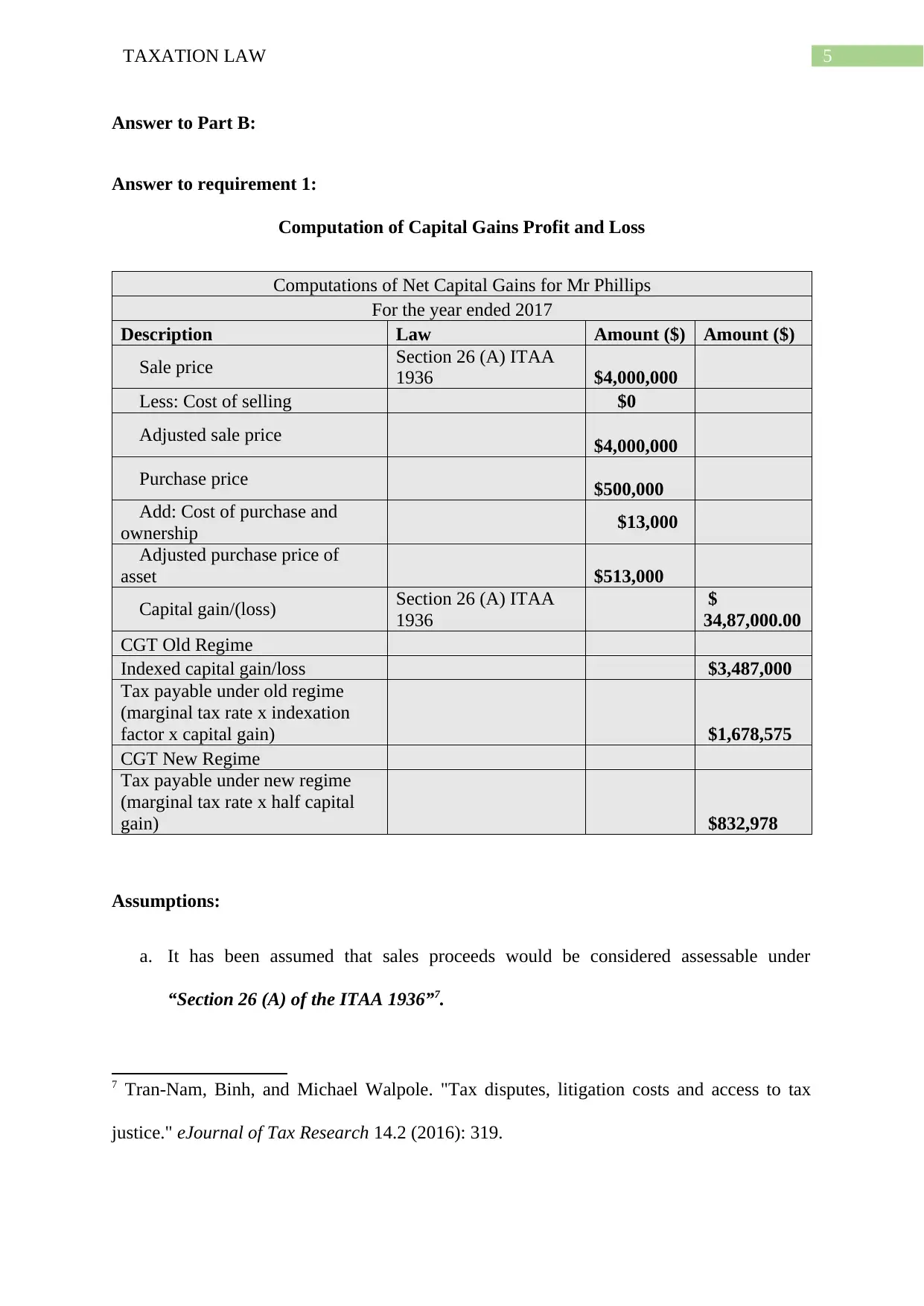
5TAXATION LAW
Answer to Part B:
Answer to requirement 1:
Computation of Capital Gains Profit and Loss
Computations of Net Capital Gains for Mr Phillips
For the year ended 2017
Description Law Amount ($) Amount ($)
Sale price Section 26 (A) ITAA
1936 $4,000,000
Less: Cost of selling $0
Adjusted sale price $4,000,000
Purchase price $500,000
Add: Cost of purchase and
ownership $13,000
Adjusted purchase price of
asset $513,000
Capital gain/(loss) Section 26 (A) ITAA
1936
$
34,87,000.00
CGT Old Regime
Indexed capital gain/loss $3,487,000
Tax payable under old regime
(marginal tax rate x indexation
factor x capital gain) $1,678,575
CGT New Regime
Tax payable under new regime
(marginal tax rate x half capital
gain) $832,978
Assumptions:
a. It has been assumed that sales proceeds would be considered assessable under
“Section 26 (A) of the ITAA 1936”7.
7 Tran-Nam, Binh, and Michael Walpole. "Tax disputes, litigation costs and access to tax
justice." eJournal of Tax Research 14.2 (2016): 319.
Answer to Part B:
Answer to requirement 1:
Computation of Capital Gains Profit and Loss
Computations of Net Capital Gains for Mr Phillips
For the year ended 2017
Description Law Amount ($) Amount ($)
Sale price Section 26 (A) ITAA
1936 $4,000,000
Less: Cost of selling $0
Adjusted sale price $4,000,000
Purchase price $500,000
Add: Cost of purchase and
ownership $13,000
Adjusted purchase price of
asset $513,000
Capital gain/(loss) Section 26 (A) ITAA
1936
$
34,87,000.00
CGT Old Regime
Indexed capital gain/loss $3,487,000
Tax payable under old regime
(marginal tax rate x indexation
factor x capital gain) $1,678,575
CGT New Regime
Tax payable under new regime
(marginal tax rate x half capital
gain) $832,978
Assumptions:
a. It has been assumed that sales proceeds would be considered assessable under
“Section 26 (A) of the ITAA 1936”7.
7 Tran-Nam, Binh, and Michael Walpole. "Tax disputes, litigation costs and access to tax
justice." eJournal of Tax Research 14.2 (2016): 319.
⊘ This is a preview!⊘
Do you want full access?
Subscribe today to unlock all pages.

Trusted by 1+ million students worldwide
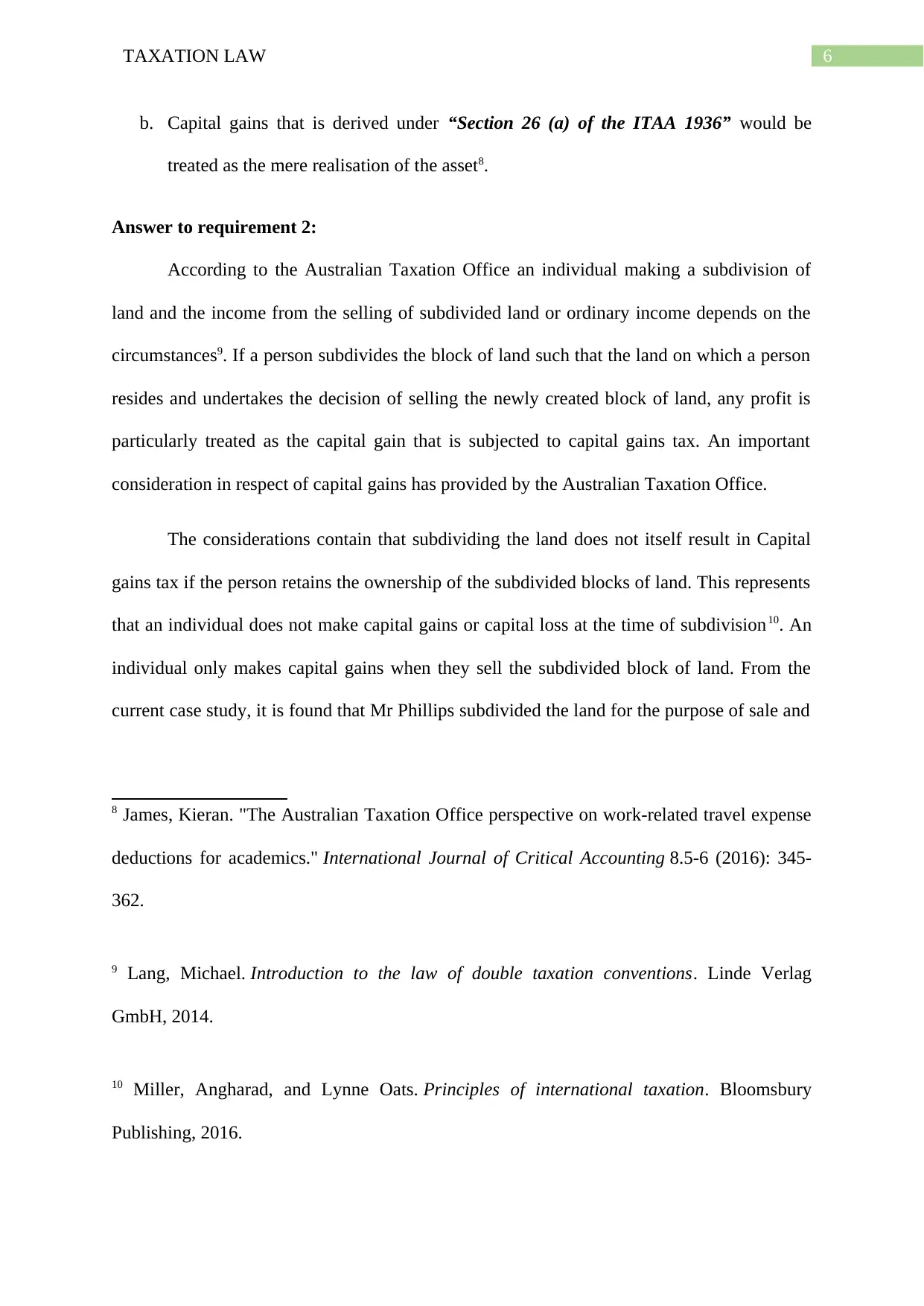
6TAXATION LAW
b. Capital gains that is derived under “Section 26 (a) of the ITAA 1936” would be
treated as the mere realisation of the asset8.
Answer to requirement 2:
According to the Australian Taxation Office an individual making a subdivision of
land and the income from the selling of subdivided land or ordinary income depends on the
circumstances9. If a person subdivides the block of land such that the land on which a person
resides and undertakes the decision of selling the newly created block of land, any profit is
particularly treated as the capital gain that is subjected to capital gains tax. An important
consideration in respect of capital gains has provided by the Australian Taxation Office.
The considerations contain that subdividing the land does not itself result in Capital
gains tax if the person retains the ownership of the subdivided blocks of land. This represents
that an individual does not make capital gains or capital loss at the time of subdivision10. An
individual only makes capital gains when they sell the subdivided block of land. From the
current case study, it is found that Mr Phillips subdivided the land for the purpose of sale and
8 James, Kieran. "The Australian Taxation Office perspective on work-related travel expense
deductions for academics." International Journal of Critical Accounting 8.5-6 (2016): 345-
362.
9 Lang, Michael. Introduction to the law of double taxation conventions. Linde Verlag
GmbH, 2014.
10 Miller, Angharad, and Lynne Oats. Principles of international taxation. Bloomsbury
Publishing, 2016.
b. Capital gains that is derived under “Section 26 (a) of the ITAA 1936” would be
treated as the mere realisation of the asset8.
Answer to requirement 2:
According to the Australian Taxation Office an individual making a subdivision of
land and the income from the selling of subdivided land or ordinary income depends on the
circumstances9. If a person subdivides the block of land such that the land on which a person
resides and undertakes the decision of selling the newly created block of land, any profit is
particularly treated as the capital gain that is subjected to capital gains tax. An important
consideration in respect of capital gains has provided by the Australian Taxation Office.
The considerations contain that subdividing the land does not itself result in Capital
gains tax if the person retains the ownership of the subdivided blocks of land. This represents
that an individual does not make capital gains or capital loss at the time of subdivision10. An
individual only makes capital gains when they sell the subdivided block of land. From the
current case study, it is found that Mr Phillips subdivided the land for the purpose of sale and
8 James, Kieran. "The Australian Taxation Office perspective on work-related travel expense
deductions for academics." International Journal of Critical Accounting 8.5-6 (2016): 345-
362.
9 Lang, Michael. Introduction to the law of double taxation conventions. Linde Verlag
GmbH, 2014.
10 Miller, Angharad, and Lynne Oats. Principles of international taxation. Bloomsbury
Publishing, 2016.
Paraphrase This Document
Need a fresh take? Get an instant paraphrase of this document with our AI Paraphraser
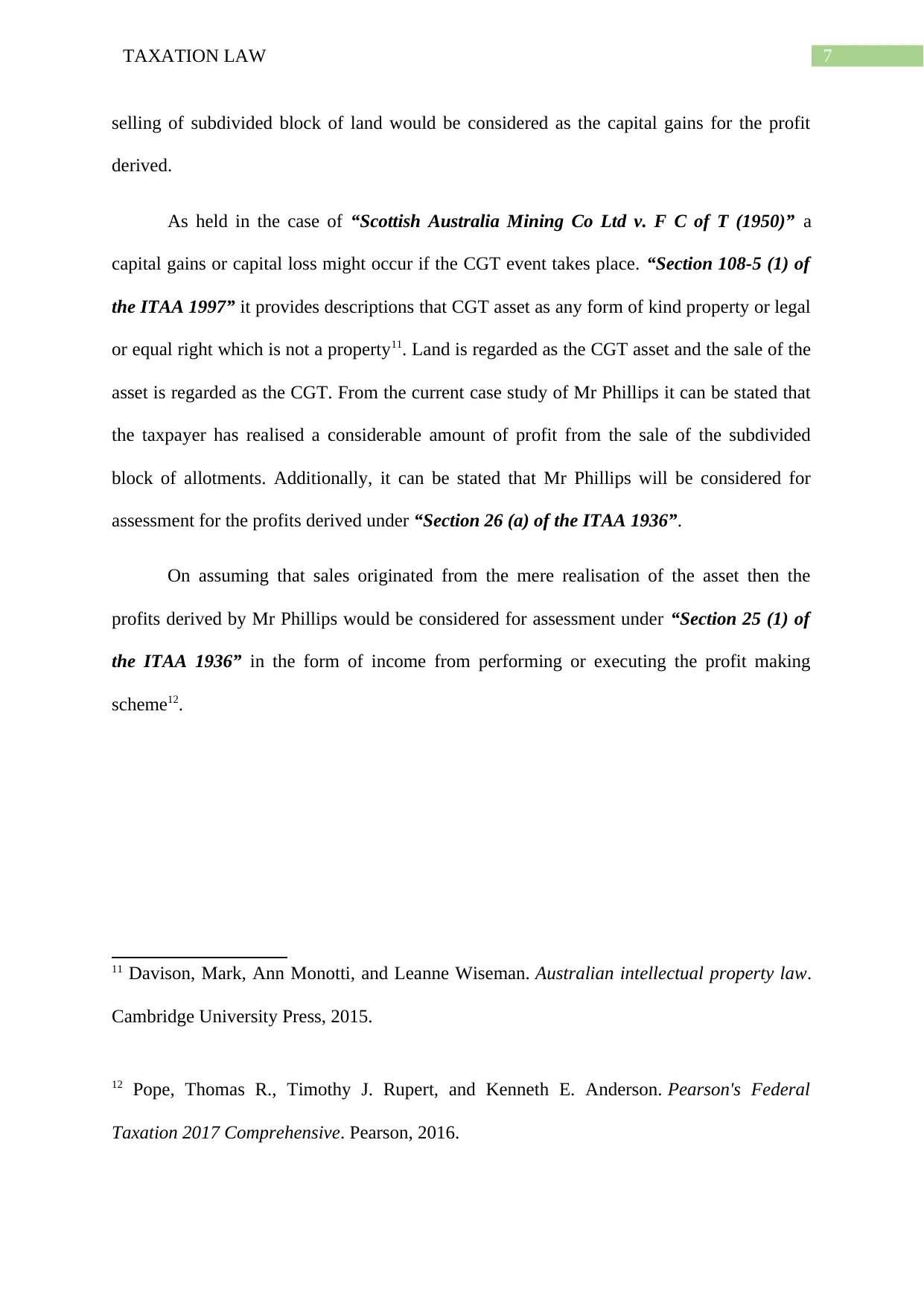
7TAXATION LAW
selling of subdivided block of land would be considered as the capital gains for the profit
derived.
As held in the case of “Scottish Australia Mining Co Ltd v. F C of T (1950)” a
capital gains or capital loss might occur if the CGT event takes place. “Section 108-5 (1) of
the ITAA 1997” it provides descriptions that CGT asset as any form of kind property or legal
or equal right which is not a property11. Land is regarded as the CGT asset and the sale of the
asset is regarded as the CGT. From the current case study of Mr Phillips it can be stated that
the taxpayer has realised a considerable amount of profit from the sale of the subdivided
block of allotments. Additionally, it can be stated that Mr Phillips will be considered for
assessment for the profits derived under “Section 26 (a) of the ITAA 1936”.
On assuming that sales originated from the mere realisation of the asset then the
profits derived by Mr Phillips would be considered for assessment under “Section 25 (1) of
the ITAA 1936” in the form of income from performing or executing the profit making
scheme12.
11 Davison, Mark, Ann Monotti, and Leanne Wiseman. Australian intellectual property law.
Cambridge University Press, 2015.
12 Pope, Thomas R., Timothy J. Rupert, and Kenneth E. Anderson. Pearson's Federal
Taxation 2017 Comprehensive. Pearson, 2016.
selling of subdivided block of land would be considered as the capital gains for the profit
derived.
As held in the case of “Scottish Australia Mining Co Ltd v. F C of T (1950)” a
capital gains or capital loss might occur if the CGT event takes place. “Section 108-5 (1) of
the ITAA 1997” it provides descriptions that CGT asset as any form of kind property or legal
or equal right which is not a property11. Land is regarded as the CGT asset and the sale of the
asset is regarded as the CGT. From the current case study of Mr Phillips it can be stated that
the taxpayer has realised a considerable amount of profit from the sale of the subdivided
block of allotments. Additionally, it can be stated that Mr Phillips will be considered for
assessment for the profits derived under “Section 26 (a) of the ITAA 1936”.
On assuming that sales originated from the mere realisation of the asset then the
profits derived by Mr Phillips would be considered for assessment under “Section 25 (1) of
the ITAA 1936” in the form of income from performing or executing the profit making
scheme12.
11 Davison, Mark, Ann Monotti, and Leanne Wiseman. Australian intellectual property law.
Cambridge University Press, 2015.
12 Pope, Thomas R., Timothy J. Rupert, and Kenneth E. Anderson. Pearson's Federal
Taxation 2017 Comprehensive. Pearson, 2016.
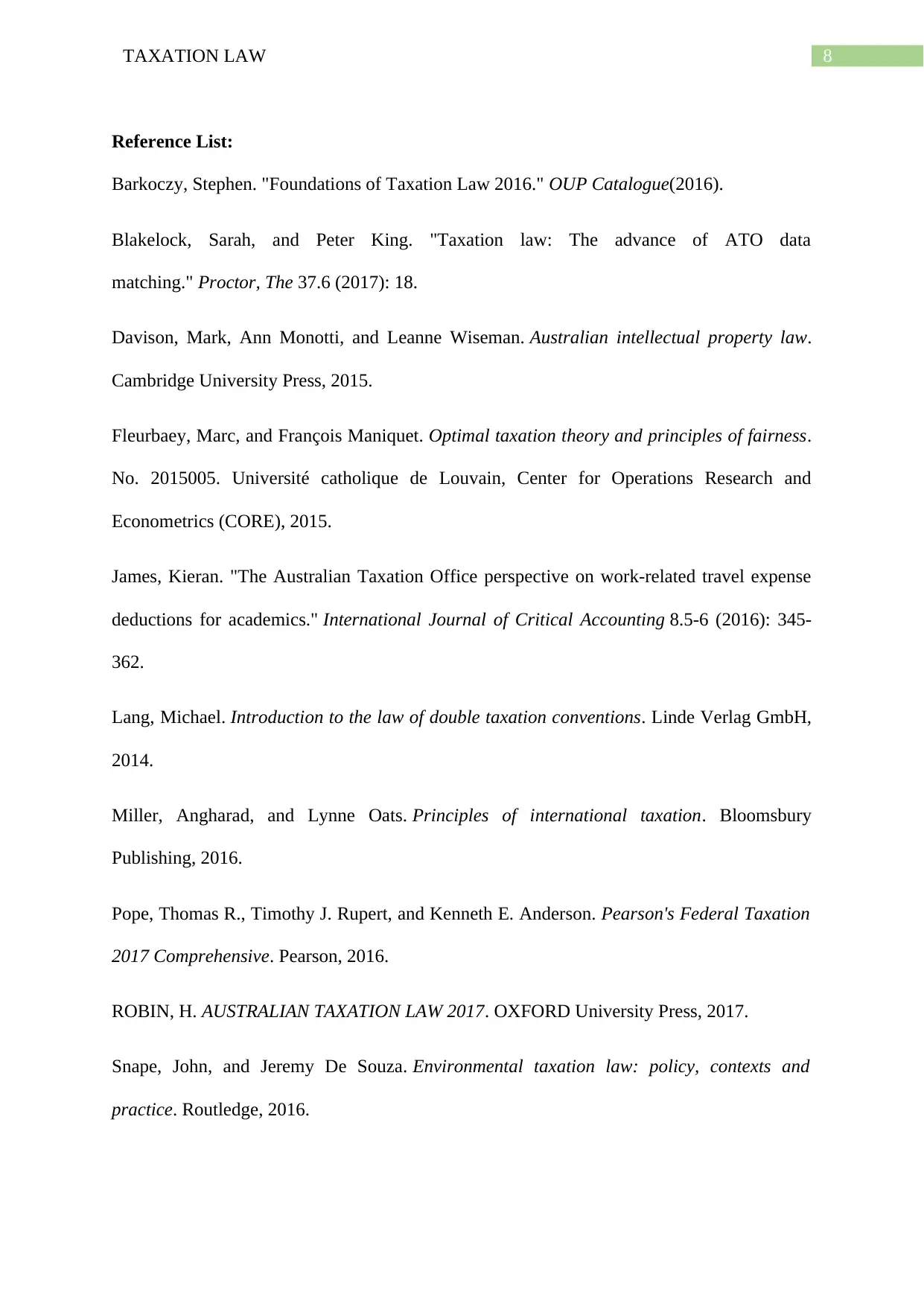
8TAXATION LAW
Reference List:
Barkoczy, Stephen. "Foundations of Taxation Law 2016." OUP Catalogue(2016).
Blakelock, Sarah, and Peter King. "Taxation law: The advance of ATO data
matching." Proctor, The 37.6 (2017): 18.
Davison, Mark, Ann Monotti, and Leanne Wiseman. Australian intellectual property law.
Cambridge University Press, 2015.
Fleurbaey, Marc, and François Maniquet. Optimal taxation theory and principles of fairness.
No. 2015005. Université catholique de Louvain, Center for Operations Research and
Econometrics (CORE), 2015.
James, Kieran. "The Australian Taxation Office perspective on work-related travel expense
deductions for academics." International Journal of Critical Accounting 8.5-6 (2016): 345-
362.
Lang, Michael. Introduction to the law of double taxation conventions. Linde Verlag GmbH,
2014.
Miller, Angharad, and Lynne Oats. Principles of international taxation. Bloomsbury
Publishing, 2016.
Pope, Thomas R., Timothy J. Rupert, and Kenneth E. Anderson. Pearson's Federal Taxation
2017 Comprehensive. Pearson, 2016.
ROBIN, H. AUSTRALIAN TAXATION LAW 2017. OXFORD University Press, 2017.
Snape, John, and Jeremy De Souza. Environmental taxation law: policy, contexts and
practice. Routledge, 2016.
Reference List:
Barkoczy, Stephen. "Foundations of Taxation Law 2016." OUP Catalogue(2016).
Blakelock, Sarah, and Peter King. "Taxation law: The advance of ATO data
matching." Proctor, The 37.6 (2017): 18.
Davison, Mark, Ann Monotti, and Leanne Wiseman. Australian intellectual property law.
Cambridge University Press, 2015.
Fleurbaey, Marc, and François Maniquet. Optimal taxation theory and principles of fairness.
No. 2015005. Université catholique de Louvain, Center for Operations Research and
Econometrics (CORE), 2015.
James, Kieran. "The Australian Taxation Office perspective on work-related travel expense
deductions for academics." International Journal of Critical Accounting 8.5-6 (2016): 345-
362.
Lang, Michael. Introduction to the law of double taxation conventions. Linde Verlag GmbH,
2014.
Miller, Angharad, and Lynne Oats. Principles of international taxation. Bloomsbury
Publishing, 2016.
Pope, Thomas R., Timothy J. Rupert, and Kenneth E. Anderson. Pearson's Federal Taxation
2017 Comprehensive. Pearson, 2016.
ROBIN, H. AUSTRALIAN TAXATION LAW 2017. OXFORD University Press, 2017.
Snape, John, and Jeremy De Souza. Environmental taxation law: policy, contexts and
practice. Routledge, 2016.
⊘ This is a preview!⊘
Do you want full access?
Subscribe today to unlock all pages.

Trusted by 1+ million students worldwide
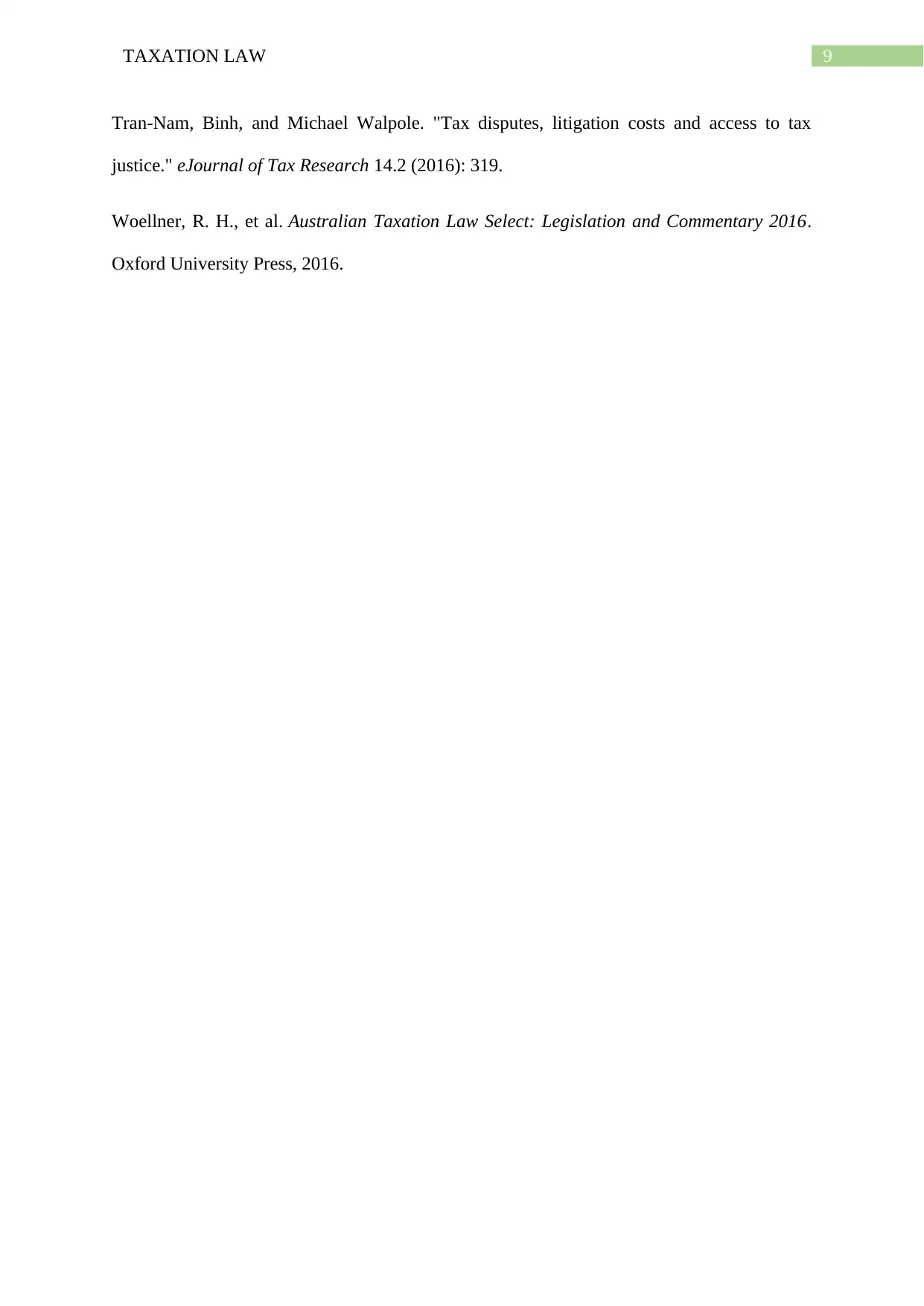
9TAXATION LAW
Tran-Nam, Binh, and Michael Walpole. "Tax disputes, litigation costs and access to tax
justice." eJournal of Tax Research 14.2 (2016): 319.
Woellner, R. H., et al. Australian Taxation Law Select: Legislation and Commentary 2016.
Oxford University Press, 2016.
Tran-Nam, Binh, and Michael Walpole. "Tax disputes, litigation costs and access to tax
justice." eJournal of Tax Research 14.2 (2016): 319.
Woellner, R. H., et al. Australian Taxation Law Select: Legislation and Commentary 2016.
Oxford University Press, 2016.
1 out of 10
Related Documents
Your All-in-One AI-Powered Toolkit for Academic Success.
+13062052269
info@desklib.com
Available 24*7 on WhatsApp / Email
![[object Object]](/_next/static/media/star-bottom.7253800d.svg)
Unlock your academic potential
Copyright © 2020–2025 A2Z Services. All Rights Reserved. Developed and managed by ZUCOL.





